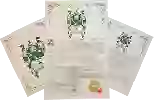
Château d'AiguilhonCuvée Conquête Côtes du Rhône
This wine generally goes well with beef, game (deer, venison) or lamb.
Food and wine pairings with Cuvée Conquête Côtes du Rhône
Pairings that work perfectly with Cuvée Conquête Côtes du Rhône
Original food and wine pairings with Cuvée Conquête Côtes du Rhône
The Cuvée Conquête Côtes du Rhône of Château d'Aiguilhon matches generally quite well with dishes of beef, lamb or game (deer, venison) such as recipes of barbecued prime rib with coarse salt, tajine of merguez and potatoes or chicken waterzooi à la gantoise.
Details and technical informations about Château d'Aiguilhon's Cuvée Conquête Côtes du Rhône.
Discover the grape variety: Ugni
Ugni blanc is a grape variety originating from Italy. It produces a variety of grape specially used for the elaboration of wine. It is rare to find this grape to eat on our tables. This variety of grape is characterized by large bunches and small to medium sized grapes. Ugni blanc can be found in many vineyards: South West, Cognac, Bordeaux, Provence & Corsica, Rhone valley, Languedoc & Roussillon, Armagnac, Loire valley, Savoie & Bugey, Beaujolais.
Informations about the Château d'Aiguilhon
The Château d'Aiguilhon is one of of the world's greatest estates. It offers 4 wines for sale in the of Côtes-du-Rhône to come and discover on site or to buy online.
The wine region of Côtes-du-Rhône
The wine region of Côtes-du-Rhône is located in the region of Rhône méridional of Rhone Valley of France. Wineries and vineyards like the Château de Beaucastel or the Chateau de Fonsalette produce mainly wines red, white and pink. The most planted grape varieties in the region of Côtes-du-Rhône are Mourvèdre, Viognier and Marsanne, they are then used in wines in blends or as a single variety. On the nose of Côtes-du-Rhône often reveals types of flavors of pineapple, red plum or sour cherry and sometimes also flavors of truffle, juniper or clove.
The wine region of Rhone Valley
The Rhone Valley is a key wine-producing region in Southeastern France. It follows the North-south course of the Rhône for nearly 240 km, from Lyon to the Rhône delta (Bouches-du-Rhône), near the Mediterranean coast. The Length of the valley means that Rhône wines are the product of a wide variety of soil types and mesoclimates. The viticultural areas of the region cover such a distance that there is a widely accepted division between its northern and southern parts.
The word of the wine: Dry extract
Non-liquid constituents of wine.












